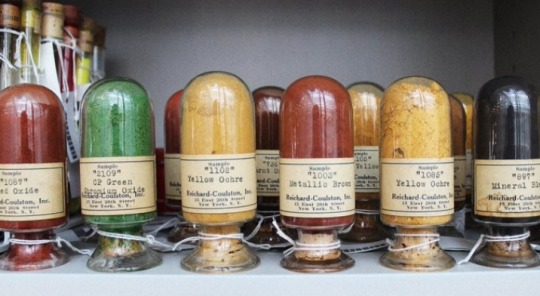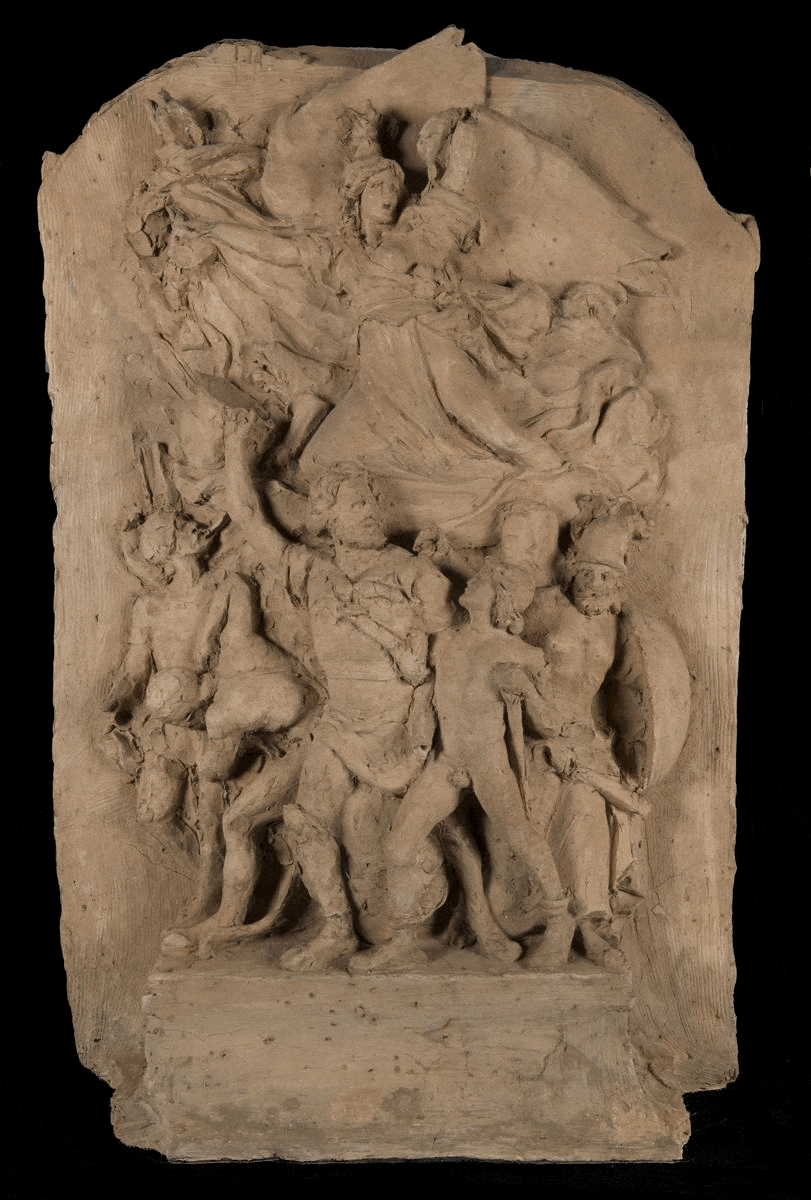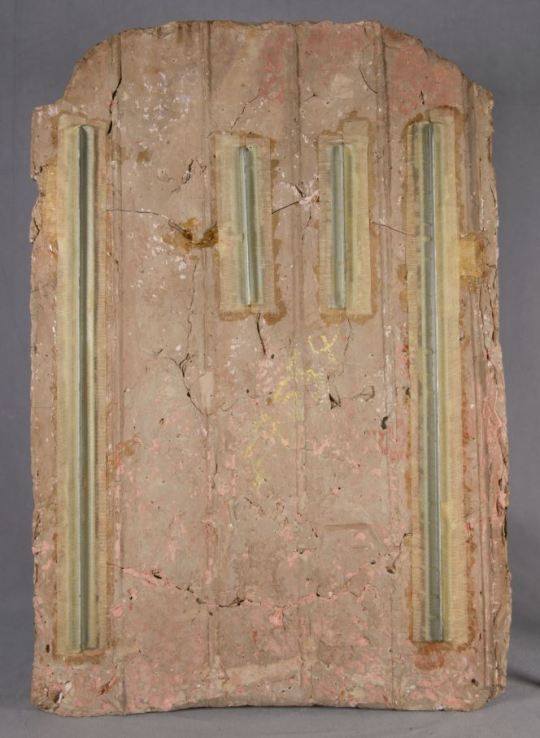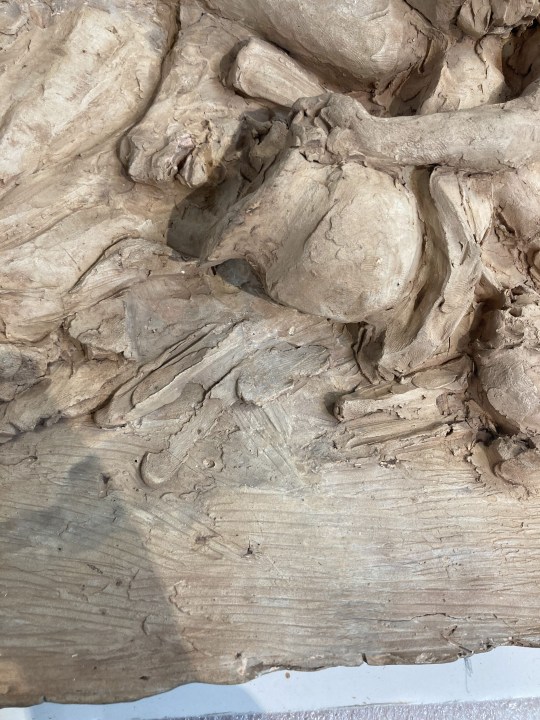#art conservation
Text
felt like compiling some b roll of this guy working on paintings, some interesting expressions.
#(this was hard bc he usually just films the paintings with no face. tease.)#baumgartner restoration#art restoration#julian baumgartner#art conservation
350 notes
·
View notes
Text

Harvard University has a library that protects the rarest colors in the world.
The Straus Center for Conservation and Technical Studies houses the Forbes Pigment Collection, which contains more than 2,500 samples of pigments, some incredibly rare and harvested from things like mummies, heavy metals, poisons, and precious minerals.
The collection was amassed by Edward Waldo Forbes (1873-1969), who directed Harvard's Fogg Museum, between 1910 and 1944.
Forbes is considered the Father of Art Conservation in the United States and spent most of his life traveling the world to collect various pigments that he used to authenticate classical Italian paintings.
The pigments are still used by art experts to authenticate and understand paintings.
#Harvard University#Straus Center for Conservation and Technical Studies#Forbes Pigment Collection#colors#pigments#Edward Forbes#Fogg Museum#Father of Art Conservation#art conservation#art#art experts#paintings#library
111 notes
·
View notes
Text

It’s me ! but Star Trek addition (・`ω´・)
I definitely think I would be a science officer working in preservation of alien cultural objects ! Star Trek, in my opinion, is space anthropology, especially since their rules and values in field work mimic those of actual ethnographers. I’d like to think any objects of cultural heritage they receive are cared for and preserved by a team of space conservators :D
38 notes
·
View notes
Text
materials used in art making in history:
squirrels
piss
bones of your enemies
cow gallbladder juice
egg
weed
red bug that really loved poland for some reason?
corrosion
mud
You don't need to buy the most expensive art materials out there to make amazing art. Your pencil is enough.
13 notes
·
View notes
Text

my fig tree
#girlblogging#chaotic academia#eastern europe#slavcore#dark academia#autumn vibes#fall#studyblr#study blog#art conservation#the bell jar#sylvia plath#fig tree
37 notes
·
View notes
Text
youtube
New video is live!
Let's talk about the hidden dangers of museum work and how there are poisonous, radioactive, and toxic items in just the darndest places. I also sprinkle in a few nuggets of wisdom for aspiring museum professionals, so be sure to check it out!
#museums#art conservation#archaeology#history#canadian history#19th century#ancient rome#professorpeachez#historical costuming#Youtube
195 notes
·
View notes
Photo

It probably doesn’t have WiFi anyway.
192 notes
·
View notes
Text
Washing some tiny 18th century drawings in a toluene bath to remove adhesive (in the fume hood of course). Do not attempt unless you’re a paper conservator. Also don’t follow for more art conservation because I rarely post it.


16 notes
·
View notes
Text
would anyone be interested if i put together a masterpost of all the freeware/web rings/digital art/game conservation I know of? I have a large list and I think it might be time I start Sharing It All
17 notes
·
View notes
Photo

This work by French sculptor François Rude is a ceramic maquette, or scale model, of a sculptural decoration for the Arc de Triomphe, a commission awarded to Rude by the French government in 1833. The final sculpture, Départ des volontaires de 1792 (Departure of the Volunteers of 1792), also known as La Marseillaise, decorates the right pillar on the front of the Arc de Triomphe and is nearly 42 ½ feet tall. It depicts men in classical-style armor, led by a winged female warrior figure. This is a stylized rendering of a real historical event, the Battle of Valmy, where a French citizen army was victorious against Prussian and Austrian forces early in the Revolutionary Wars after the French Revolution.
This maquette is considerably smaller at only 27 ½ inches tall, but what it lacks in size it makes up for in sheer dynamism. The hand of the artist is visible in the roughly modeled surface and the abundant tool and finger marks. Though the figures are not carefully finished, they nevertheless seem alive, in fluid motion. The variegated colors and many inclusions and imperfections in the ceramic body hint to Rude using a lower quality clay which may never have meant to have been fired; sculptors often use clay to work out their thoughts before recycling it to craft the next iteration of their ideas. For whatever reason, however, this piece of sculpting was deemed important enough to be saved by firing it. The many cracks in the piece may have occurred during the firing process due to the impurities in the clay.

Above: detail of rightmost figure, showing toolmarks and fingerprints in the clay
Before conservation could begin on the sculpture, it had to be assessed to determine what prior treatment it had undergone. Thankfully, in this case, we have records of its treatment in 1984, as well as notes from former Brooklyn Museum conservator Jane Carpenter upon its acquisition by the Brooklyn Museum in 1989. Some time before 1984, both of the female figure’s hands had broken off and were lost, as were the proper right hands of two of the male figures. The work had suffered severe damage in the form of a horizontal break across the entire sculpture at the female figure’s waist, and was repaired (along with other cracks and breaks) with tinted plaster, which also covered the entire back surface. Finally, the entire front surface was coated with reddish-brown pigment. In 1984, the plaster and reddish-brown pigment was (mostly) removed, and the back was reinforced with four aluminum brackets adhered with epoxy and cotton tape. Losses along the horizontal break were filled in and inpainted with gouache.

Above: the back side of the maquette before treatment
There were many spots of plaster and reddish-brown pigment that remained from the previous treatments, and there was also something oddly flat and one-dimensional about the color, too. Typically, a conservator will cover as little of the object’s surface as possible when inpainting fill material to match the surrounding area; in this case, it was found that almost the entire surface was coated with gouache! This may have been done to unify the repair work and create a more homogeneous appearance, as the gouache obscured the mottled coloring of the clay. However, this is an important feature in understanding the complicated history of this sculpture as well as its status as a “process object” created as part of a larger work. Though it is unclear what the “original” surface of the maquette may have looked like at the time of its creation, it was determined that removal of the gouache to reveal the current surface was preferable.

Above: removal of gouache with a swab, revealing ceramic surface underneath
Since gouache is soluble in water, cleaning the surface of the maquette was simple yet time-consuming. Small cotton swabs were hand-made, dampened, and carefully rolled across the surface. Along with the gouache, more of the old reddish-brown pigment was removed, though traces still remain in the many crevices. In total, wet cleaning the sculpture took over fifteen hours of work.


Above: before (left) and after (right) inpainting a filled crack
Instead of completely removing and redoing the old fills, which were made of a cellulose-based filler that appeared perfectly stable, they were shaped and resurfaced using an acrylic-based modern product to help them more effectively blend texturally into the surrounding area. Finally, since the color of the fills didn’t perfectly match the ceramic, they were aesthetically integrated with watercolor and gouache (applied only over the fills and not the entire surface!). These materials are easily soluble in water so the piece can be re-treated in the future if necessary. Now, instead of obscuring the complex and interesting surface of the maquette, it can be more fully appreciated as an object that gives unique and intimate insight into a great sculptor’s working processes.
Below: the maquette after treatment

Written by Celeste Mahoney, Assistant Objects Conservator
#Brooklyn Museum#brooklyn#museum#art#conservation#art conservation#BkMConservation#sculpture#francoise rude#maquette#Arc de Triomphe
39 notes
·
View notes
Text
#tiktok#conservation#art conservation#art history#art#the metropolitan museum of art#edgar degas#metropolitan museum of art
6 notes
·
View notes
Text
87% of Classic Games (Any game released before 2010, including games like Super Mario Galaxy, Gears of War2, and Mirror's Edge) have been declared Missing.
Game companies have lobbied against conservation, saying that they do enough conservation by working publicly. This has since been disproven. Game companies do NOT do enough to conserve their games.
For many games, the only option is pirating. Game history experts say that if people didn't break or at least bend the law (whether as a consumer or while working on a game themselves) we wouldn't even have 13% of classic games (any game made before 2010).
For other games, the only option is finding it on a disk, though this is less likely. Many e-game store fronts (like the Xbox 360 store) will close, taking the only version we have of (some) those games with it. The Xbox 360 store will be shutting down July 2024.
The Wii U & Nintendo 3DS stores have recently closed. Ubisoft is determined to keep their costumers on subscriptions and when the games stop being worked on, they will shut down entirely. This includes both multiplayer AND singleplayer games.
You can help game conservation by going to StopKillingGames .com
#politics#us politics#world politics#lgbt#lgbtqia#lgbtq#lgbtq+#queer#art conservation#game conservation#video game conservation
3 notes
·
View notes
Text
are there any conservators here? I’m starting my masters in conservation in September and I’m so terrified I made the wrong choice
#it’s mostly bc of the job market#lmao#conservator#conservation#archaeological conservation#historical conservation#art conservation
10 notes
·
View notes
Video
youtube
The Conservation of The Assassination of Archimedes ASMR Version
the guy who restores this painting is amazing! must watch for any artist or art fan
#art restoration#art conservation#art#artwork#the conservation of the assassination of archimedes#the assassination of archimedes
2 notes
·
View notes
Text
‘His Name Was Bélizaire’: Rare Portrait of Enslaved Child Arrives at the...
youtube
10 notes
·
View notes